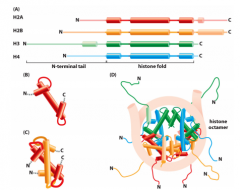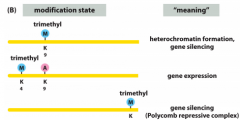![]()
![]()
![]()
Use LEFT and RIGHT arrow keys to navigate between flashcards;
Use UP and DOWN arrow keys to flip the card;
H to show hint;
A reads text to speech;
19 Cards in this Set
- Front
- Back
|
Cells maintain their specialised characteristics. Give experimental evidence: |
- transplanting a nucleus from differentiating muscle into a enucleated egg - many progeny cells express a muscle marker in non-muscle regions; |
|
|
How is gene expression profile passed on from parent to daughter cell? |
- Cells retain a record of signals their ancestors received during Development - instead of continuously receiving instructions from the surrounding |
|
|
Hox genes give each cell a permanent record of their A/P position. How? |
- 2 memory mechanisms - Hox genes autoactivate their expression - Trithorax and polycomb groups of proteins - stamp Hox gene chromatin with a heritable record of gene activation or repression; they are key general regulators of chromatin |
|
|
What is the function of Polycomb? |
- it maintains repressed Hox expression |
|
|
What is the function of Trithorax? |
- maintain expression of Hox genes |
|
|
What does a mutation in Polycomb cause? |
- Initially Hox gene expression is normal, but then it becomes switched on all along the A/P axis. |
|
|
How is cell memory set up through a positive feedback loop? |
- once activated by some external signal, the feedback loop will continually activate itself, even as the cell divides and the signal is taken away. |
|
|
Give an example of how state of chromatin can affect gene expression: |
- X-chromosome inactivation - early in development one of the two copies is inactivated in a form of heterochromatin; - done by non-coding RNA called Xist |
|
|
What is the structural organisation of the core histones? |

histone tails extend from the core |
|
|
What epigenetic marks processes lay markers on chromatin (histone tails) that change DNA expression? |
- methylation - phosphorylation - acetylation |
|
|
What is the job of transcription factors? |
- they direct local alterations in chromatin structure |
|
|
What are four types in which transcription factors direct local alterations in Chromatin structure? |
- nucleosome sliding - allsows access of transcription machinery to DNA - transcription machinery assembles on nucleosome-free DNA - histone variants allow greater access to nucleosomal DNA - specific patterns of histone modification destabilize compact forms of chromatin and attract components of transcription machinery |
|
|
Meanings of some histone modifications: |

|
|
|
What are the two main types of epigenetic mechanisms? |
- cis-acting - trans-acting - both are inherited |
|
|
What are the two types of cis-acting epigenetic mechanisms? |
- DNA methylation - Histone modification (used by Polycomb and Trithorax) |
|
|
What are the two types of trans-acting epigenetic mechanisms? |
- positive feedback loop by transcription regulator (simplest most common route) - protein aggregation state |
|
|
How to embryonic stem cells maintain their cell state? |
- similar to the way differentiated cells keep their state - Polycomb is involved - direct and indirect positive feedback expression of key transcription factors |
|
|
Give examples of when differentiated cell state is not permanent? |
- Forced transdifferentiation - heterokaryon experiments - nuclear and cellular reprogramming |
|
|
What is forced transdifferentiation? |
- when one mature somatic cell changes into another type of mature somatic cell without undergoing pluripotency stage - Forcing mouse embryonic fibroblasts to express MyoD was found to be sufficient to turn those cells into myoblasts. |

